Effect of Aging Heat Treatment on Wear Behavior and Microstructure Characterization of Newly Developed Al7075+Ti Alloys
Abstract
:1. Introduction
2. Materials and Methods
3. Results
3.1. XRD Analysis
3.2. Microstructural Characterization
3.3. Hardness-Test Results
3.4. Wear-Test Results
4. Conclusions
- According to ASTM E112 [33], the average grain sizes of the unrolled Al7075+0%Ti, Al7075+2%Ti, Al7075+4%Ti, and Al7075+8%Ti alloys were determined to be 55, 28, 20, and 12 µm, respectively. On the other hand, the average grain sizes of the rolled Al7075+0%Ti, Al7075+2%Ti, Al7075+4%Ti, and Al7075+8%Ti alloys were determined to be 48, 22, 15, and 9 µm, respectively. It was observed that the Al3Ti intermetallic phases increased with better titanium reinforcement in the microstructure. It was also shown that the intermetallic Al3Ti phases were generally acicular in the rolled alloys, whereas they were usually spherical in the unrolled alloys.
- The peak hardness values of the unrolled Al7075+0%Ti and rolled Al7075+0%Ti alloys after 48 h T6 aging heat treatment increased by 11%, whereas the same values for the unrolled Al7075+8%Ti- and rolled Al7075+8%Ti-reinforced alloys increased by 9.4%. On the other hand, the increased rates of hardness of the unrolled and rolled Al7075 alloys with Ti reinforcement of up to 8% were close to each other, at 33%.
- The wear rates of the examined Al7075 alloys were reduced by approximately 50% when 8% Ti was added. The difference in wear rates between unrolled and rolled Al7075+0%Ti alloys was 31%, whereas it was only 6% for the unrolled and rolled Al7075+8%Ti alloys. This finding is in agreement with the difference in hardness between the examined unrolled and rolled alloys.
- It was observed that the wear behaviors of the Al7075+0%Ti- and Al7075+8%Ti-reinforced alloys showed higher oxidation under rolled conditions compared to unrolled conditions. Based on these findings and the friction-coefficient data, it can be said that rolling and reinforcement with up to 8% Ti increases surface oxidation during wear, thus protecting the surface and reducing the coefficient of friction.
Author Contributions
Funding
Institutional Review Board Statement
Informed Consent Statement
Data Availability Statement
Conflicts of Interest
References
- Deaquino-Lara, R.; Gutiérrez-Castañeda, E.; Estrada-Guel, I.; Hinojosa-Ruiz, G.; García-Sánchez, E.; Herrera-Ramírez, J.M.; Pérez-Bustamante, R.; Martínez-Sánchez, R. Structural Characterization of Aluminium Alloy 7075-Graphite Composites Fabricated by Mechanical Alloying and Hot Extrusion. Mater. Des. 2014, 53, 1104–1111. [Google Scholar] [CrossRef]
- Miller, W.S.; Zhuang, L.; Bottema, J.; Wittebrood, A.J.; De Smet, P.; Haszler, A.; Vieregge, A. Recent Development in Aluminium Alloys for the Automotive Industry. Mater. Sci. Eng. A 2000, 280, 37–49. [Google Scholar] [CrossRef]
- Robson, J.D. Microstructural Evolution in Aluminium Alloy 7050 during Processing. Mater. Sci. Eng. A 2004, 382, 112–121. [Google Scholar] [CrossRef]
- Liu, Z.; Han, Q.; Li, J. Fabrication of in Situ Al3Ti/Al Composites by Using Ultrasound Assisted Direct Reaction between Solid Ti Powders and Liquid Al. Powder Technol. 2013, 247, 55–59. [Google Scholar] [CrossRef]
- Shivananda Murthy, K.V.; Girish, D.P.; Keshavamurthy, R.; Varol, T.; Koppad, P.G. Mechanical and Thermal Properties of AA7075/TiO2/Fly Ash Hybrid Composites Obtained by Hot Forging. Prog. Nat. Sci. Mater. Int. 2017, 27, 474–481. [Google Scholar] [CrossRef]
- Rometsch, P.A.; Zhang, Y.; Knight, S. Heat Treatment of 7xxx Series Aluminium Alloys—Some Recent Developments. Trans. Nonferrous Met. Soc. China (Engl. Ed.) 2014, 24, 2003–2017. [Google Scholar] [CrossRef]
- Wolverton, C. Crystal Structure and Stability of Complex Precipitate Phases in Al-Cu-Mg-(Si) and Al-Zn-Mg Alloys. Acta Mater. 2001, 49, 3129–3142. [Google Scholar] [CrossRef]
- Kogtenkova, O.A.; Mazilkin, A.A.; Straumal, B.B.; Abrosimova, G.E.; Zięba, P.; Czeppe, T.; Baretzky, B.; Valiev, R.Z. Phase Transformations in Al-Mg-Zn Alloys during High Pressure Torsion and Subsequent Heating. J. Mater. Sci. 2013, 48, 4758–4765. [Google Scholar] [CrossRef]
- Uenishi, K.; Matsubara, T.; Kambara, M.; Kobayashi, K.F. Nanostructured Titanium-Aluminides and Their Composites Formed by Combustion Synthesis of Mechanically Alloyed Powders. Scr. Mater. 2001, 44, 2093–2097. [Google Scholar] [CrossRef]
- Kumar, A.; Patnaik, A.; Bhat, I.K. Effect of Titanium Metal Powder on Thermo- Mechanical and Sliding Wear Behavior of Al7075/Ti Alloy Composites for Gear Application. Mater. Today Proc. 2018, 5, 16919–16927. [Google Scholar] [CrossRef]
- Michael Rajan, H.B.; Ramabalan, S.; Dinaharan, I.; Vijay, S.J. Synthesis and Characterization of in Situ Formed Titanium Diboride Particulate Reinforced AA7075 Aluminum Alloy Cast Composites. Mater. Des. 2013, 44, 438–445. [Google Scholar] [CrossRef]
- Surya, M.S.; Prasanthi, G.; Gugulothu, S.K. Investigation of Mechanical and Wear Behaviour of Al7075/SiC Composites Using Response Surface Methodology. Silicon 2021, 13, 2369–2379. [Google Scholar] [CrossRef]
- Gajakosh, A.K.; Keshavamurthy, R.; Jagadeesha, T.; Kumar, R.S. Investigations on Mechanical Behavior of Hot Rolled Al7075/TiO2/Gr Hybrid Composites. Ceram. Int. 2021, 47, 14775–14789. [Google Scholar] [CrossRef]
- Qin, L.; Wang, H.; Cui, S.; Wu, Q.; Fan, M.; Yang, Z.; Tao, J. Characterization and Formability of Titanium/Aluminum Laminate Composites Fabricated by Hot Pressing. J. Mater. Eng. Perform. 2017, 26, 3579–3587. [Google Scholar] [CrossRef]
- Anand Partheeban, C.M.; Rajendran, M.; Vettivel, S.C.; Suresh, S.; Moorthi, N.S.V. Mechanical Behavior and Failure Analysis Using Online Acoustic Emission on Nano-Graphite Reinforced Al6061-10TiB2 Hybrid Composite Using Powder Metallurgy. Mater. Sci. Eng. A 2015, 632, 1–13. [Google Scholar] [CrossRef]
- Wu, J.M.; Zheng, S.L.; Li, Z.Z. Thermal Stability and Its Effects on the Mechanical Properties of Rapidly Solidified Al-Ti Alloys. Mater. Sci. Eng. A 2000, 289, 246–254. [Google Scholar] [CrossRef]
- Wang, S.H.; Kao, P.W. The Strengthening Effect of Al3Ti in High Temperature Deformation of Al-Al3Ti Composites. Acta Mater. 1998, 46, 2675–2682. [Google Scholar] [CrossRef]
- Guoxian, L.; Zhichao, L.; Erde, W. Thermal Stability and Mechanical Properties of Mechanically Alloyed Al-10Ti Alloy. J. Mater. Sci. 1996, 31, 901–904. [Google Scholar] [CrossRef]
- Liu, Z.; Rakita, M.; Wang, X.; Xu, W.; Han, Q. In Situ Formed Al3Ti Particles in Al Alloy Matrix and Their Effects on the Microstructure and Mechanical Properties of 7075 Alloy. J. Mater. Res. 2014, 29, 1354–1361. [Google Scholar] [CrossRef]
- Li, G.R.; Wang, H.M.; Zhao, Y.T.; Chen, D.B.; Chen, G.; Cheng, X.N. Microstructure of in Situ Al3Ti/6351Al Composites Fabricated with Electromagnetic Stirring and Fluxes. Trans. Nonferrous Met. Soc. China (Engl. Ed.) 2010, 20, 577–583. [Google Scholar] [CrossRef]
- Wang, X.; Jha, A.; Brydson, R. In Situ Fabrication of Al3Ti Particle Reinforced Aluminium Alloy Metal-Matrix Composites. Mater. Sci. Eng. A 2004, 364, 339–345. [Google Scholar] [CrossRef]
- Shaeri, M.H.; Shaeri, M.; Salehi, M.T.; Seyyedein, S.H.; Abutalebi, M.R. Effect of Equal Channel Angular Pressing on Aging Treatment of Al-7075 Alloy. Prog. Nat. Sci. Mater. Int. 2015, 25, 159–168. [Google Scholar] [CrossRef] [Green Version]
- Ramesh, C.S.; Khan, A.R.A.; Ravikumar, N.; Savanprabhu, P. Prediction of Wear Coefficient of Al6061-TiO2 Composites. Wear 2005, 259, 602–608. [Google Scholar] [CrossRef]
- Math, R.G.; Reddy, A.C. Inference of Macro-Particles on Wear Rate of AA6061/TiO2 Metal Matrix Composites. In Proceedings of the 4th International Conference on Modern Materials and Manufacturing, Chennai, India, 7–8 December 2012; pp. 329–333. [Google Scholar]
- Radhika, N.; Sasikumar, J.; Arulmozhivarman, J. Tribo-Mechanical Behaviour of Ti-Based Particulate Reinforced As-Cast and Heat Treated A359 Composites. Silicon 2020, 12, 2769–2782. [Google Scholar] [CrossRef]
- Ben Naser, T.S.; Krállics, G. The Effect of Multiple Forging and Cold Rolling on Bending and Tensile Behavior of Al7075 Alloy. Mater. Sci. Forum 2013, 729, 464–469. [Google Scholar] [CrossRef]
- Panigrahi, S.K.; Jayaganthan, R. Development of Ultrafine Grained High Strength Age Hardenable Al7075 Alloy by Cryorolling. Mater. Des. 2011, 32, 3150–3160. [Google Scholar] [CrossRef]
- Reddy, P.V.; Prasad, P.R.; Krishnudu, D.M.; Goud, E.V. An Investigation on Mechanical and Wear Characteristics of Al 6063/TiC Metal Matrix Composites Using RSM. J. Bio-Tribo-Corros. 2019, 5, 90. [Google Scholar] [CrossRef]
- Niranjan, K.; Lakshminarayanan, P.R. Dry Sliding Wear Behaviour of in Situ Al-TiB2 Composites. Mater. Des. 2013, 47, 167–173. [Google Scholar] [CrossRef]
- Nayan, N.; Narayana Murty, S.Y.S.; Gotvind; Mittal, M.C.; Sinha, P.P. Optimization of Homogenizing Mode for Aluminum Alloy AA7075 Using Calorimetric and Microstructural Studies. Met. Sci. Heat Treat. 2009, 51, 330–337. [Google Scholar] [CrossRef]
- Chaijaruwanich, A.; Lee, P.D.; Dashwood, R.J.; Youssef, Y.M.; Nagaumi, H. Evolution of Pore Morphology and Distribution during the Homogenization of Direct Chill Cast Al-Mg Alloys. Acta Mater. 2007, 55, 285–293. [Google Scholar] [CrossRef]
- Goswami, R.; Lynch, S.; Holroyd, N.J.H.; Knight, S.P.; Holtz, R.L. Evolution of Grain Boundary Precipitates in Al 7075 Upon Aging and Correlation with Stress Corrosion Cracking Behavior. Metall. Mater. Trans. A 2013, 44, 1268–1278. [Google Scholar] [CrossRef]
- ASTM E112; Standard Test Methods for Determining Average Grain Size. ASTM: West Conshocken, PA, USA, 1996.
- Chen, X.H.; Yan, H.; Jie, X.P. Effects of Ti Addition on Microstructure and Mechanical Properties of 7075 Alloy. Int. J. Cast Met. Res. 2015, 28, 151–157. [Google Scholar] [CrossRef]

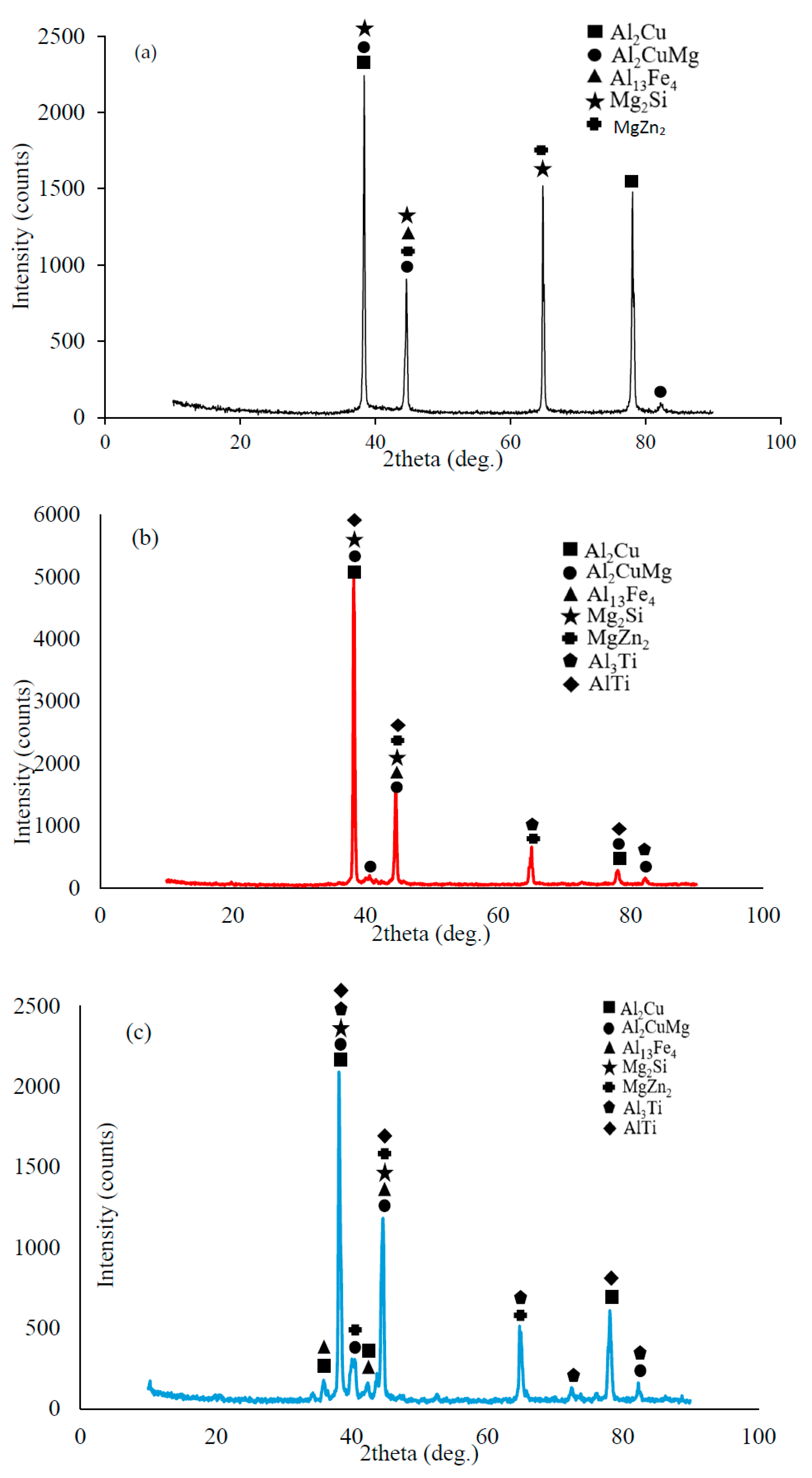

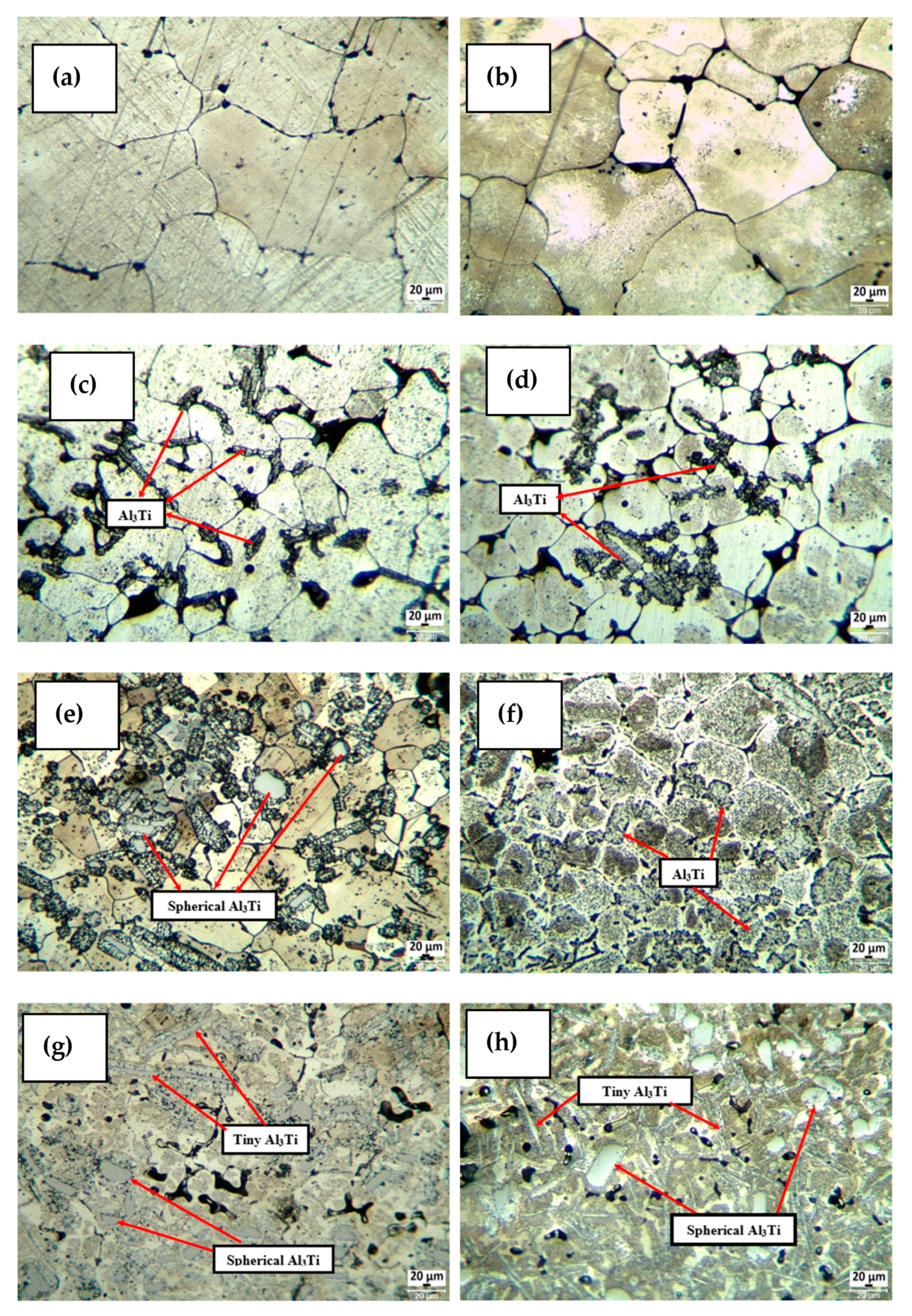
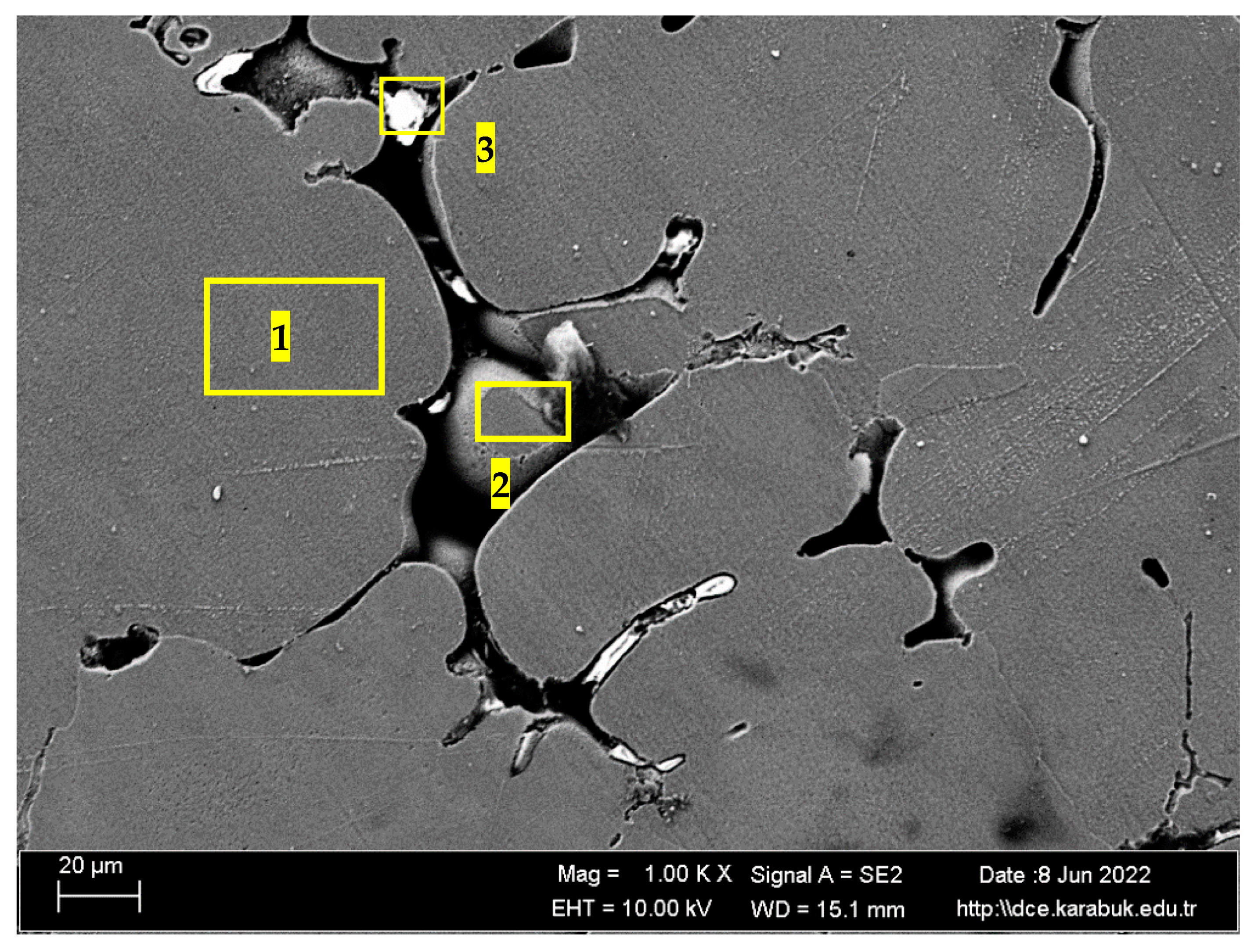
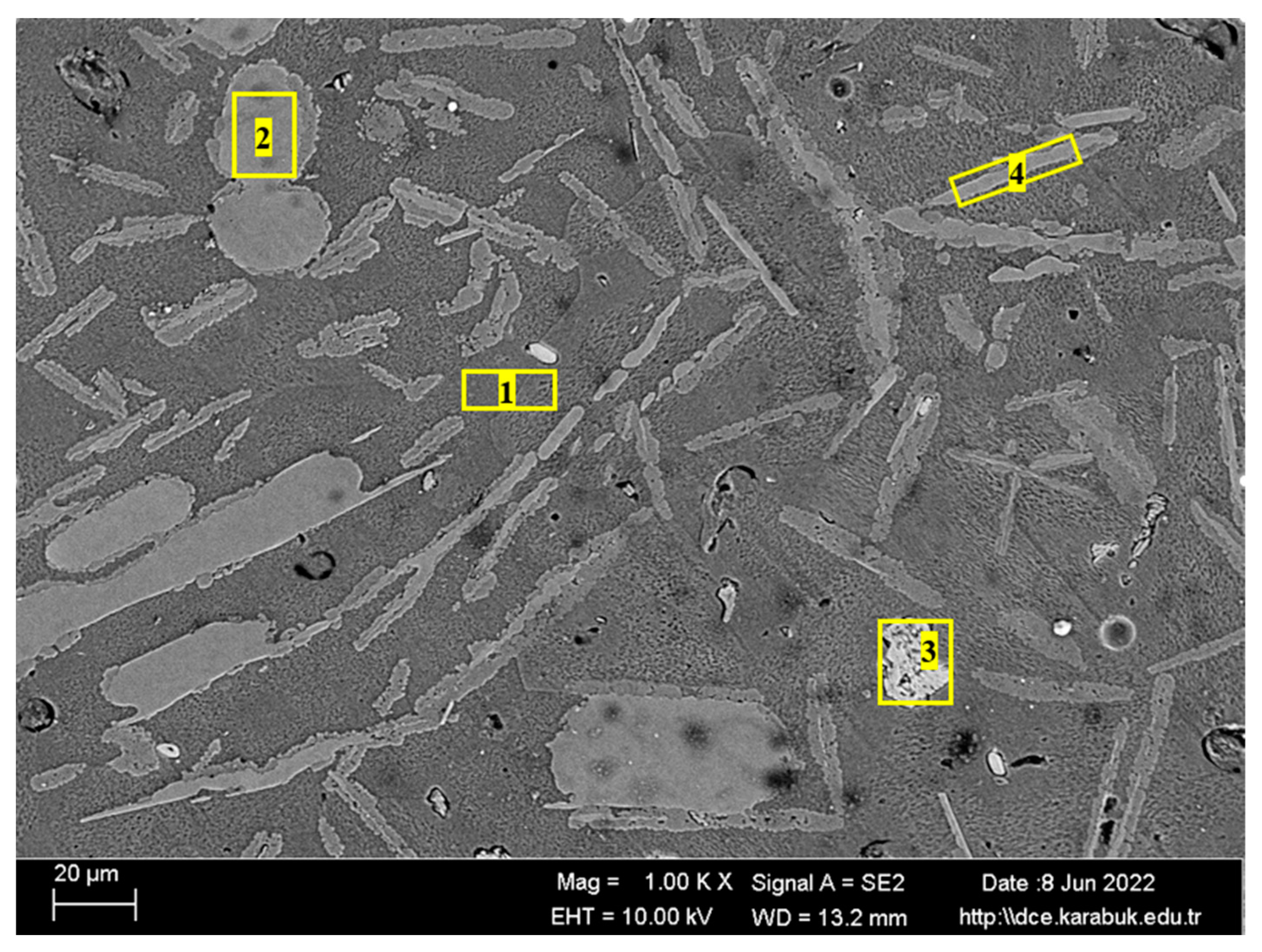
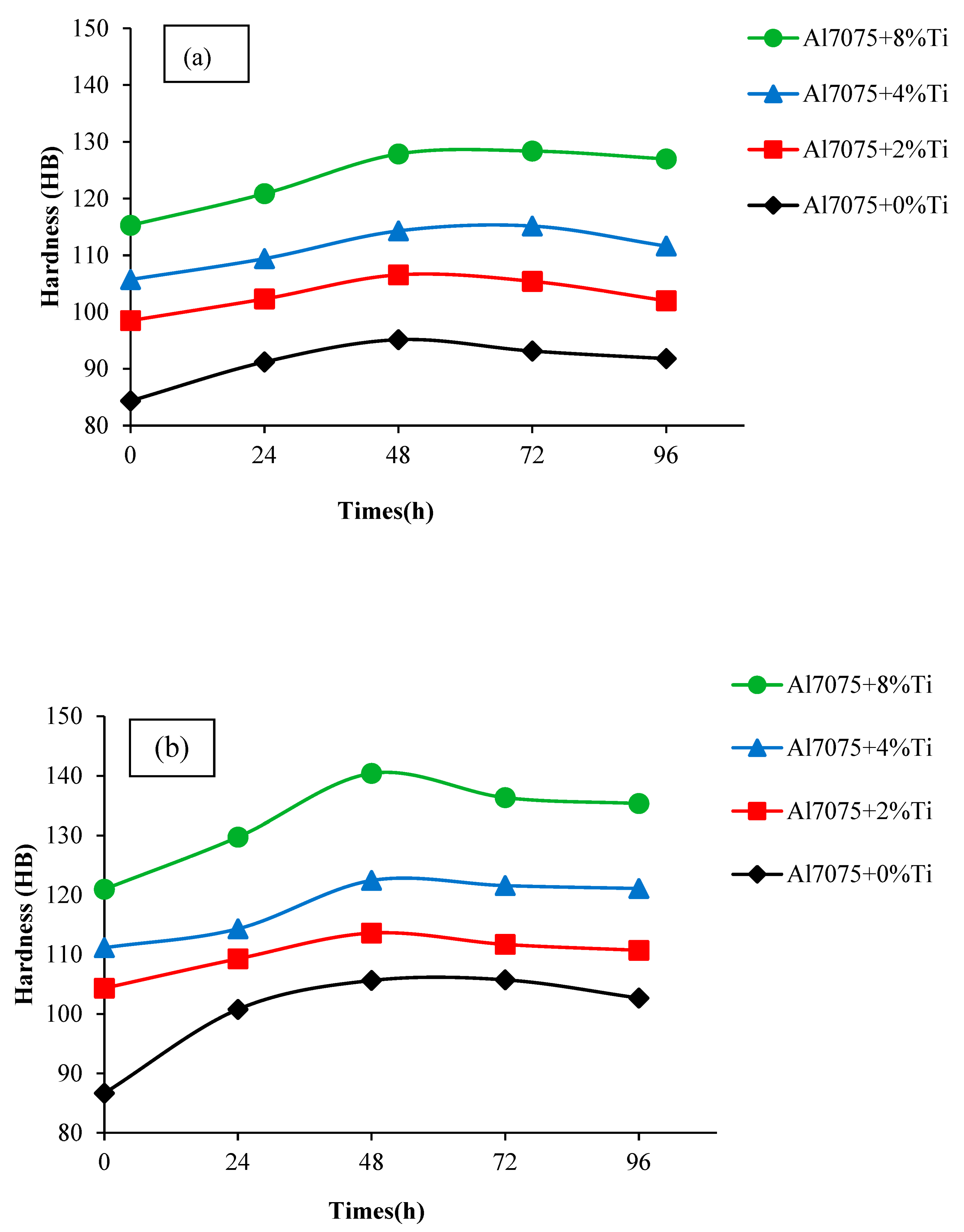

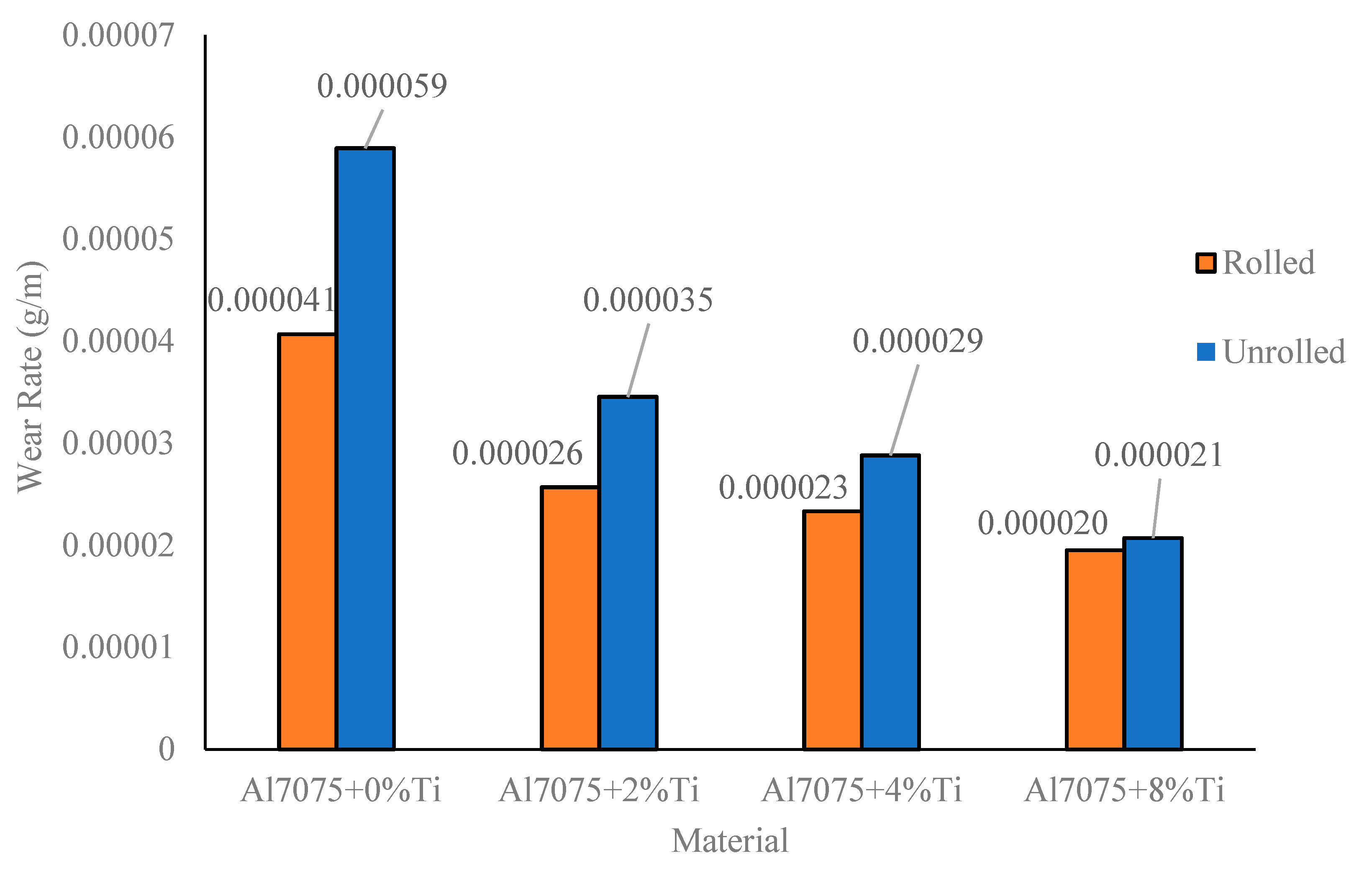
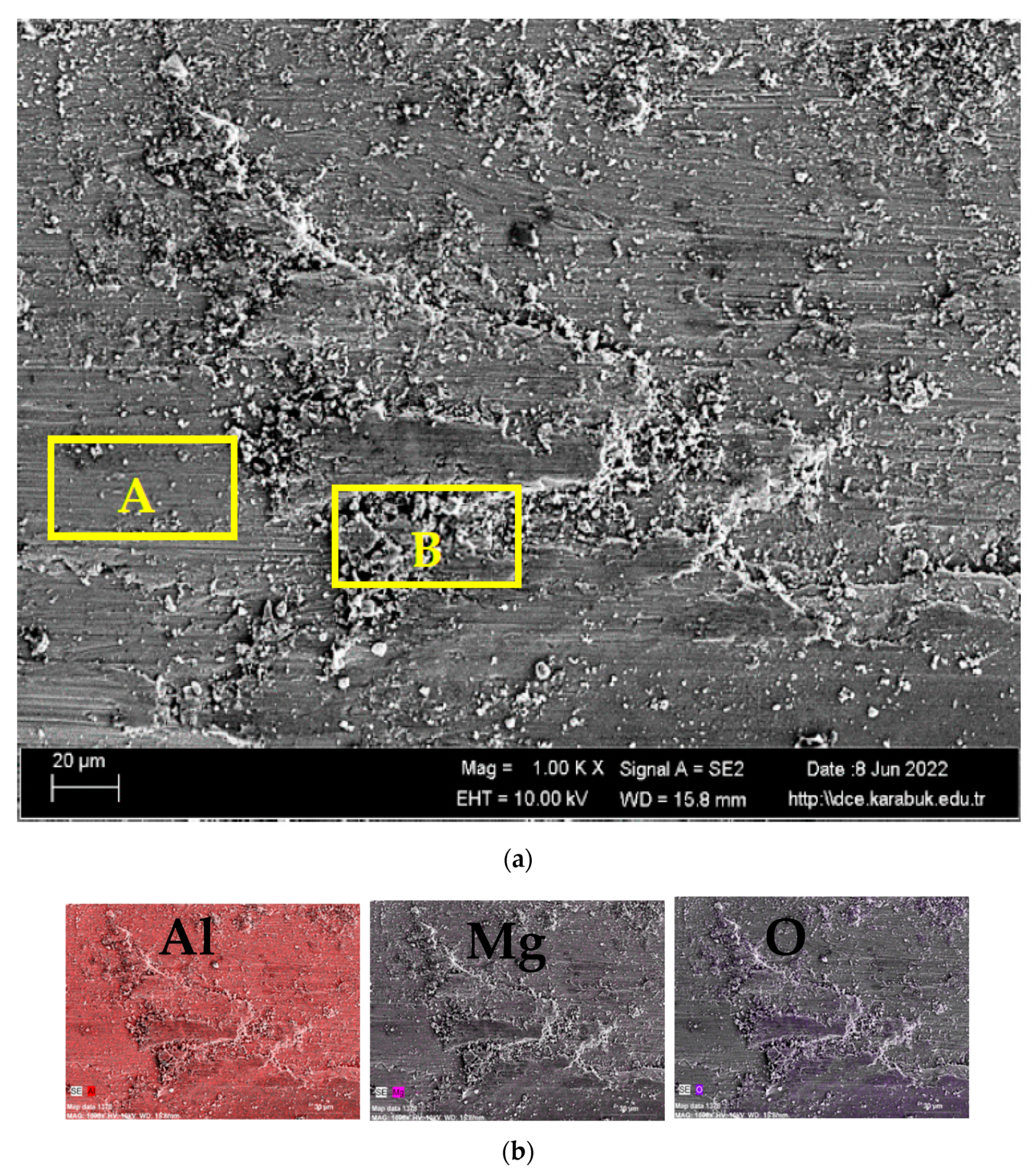
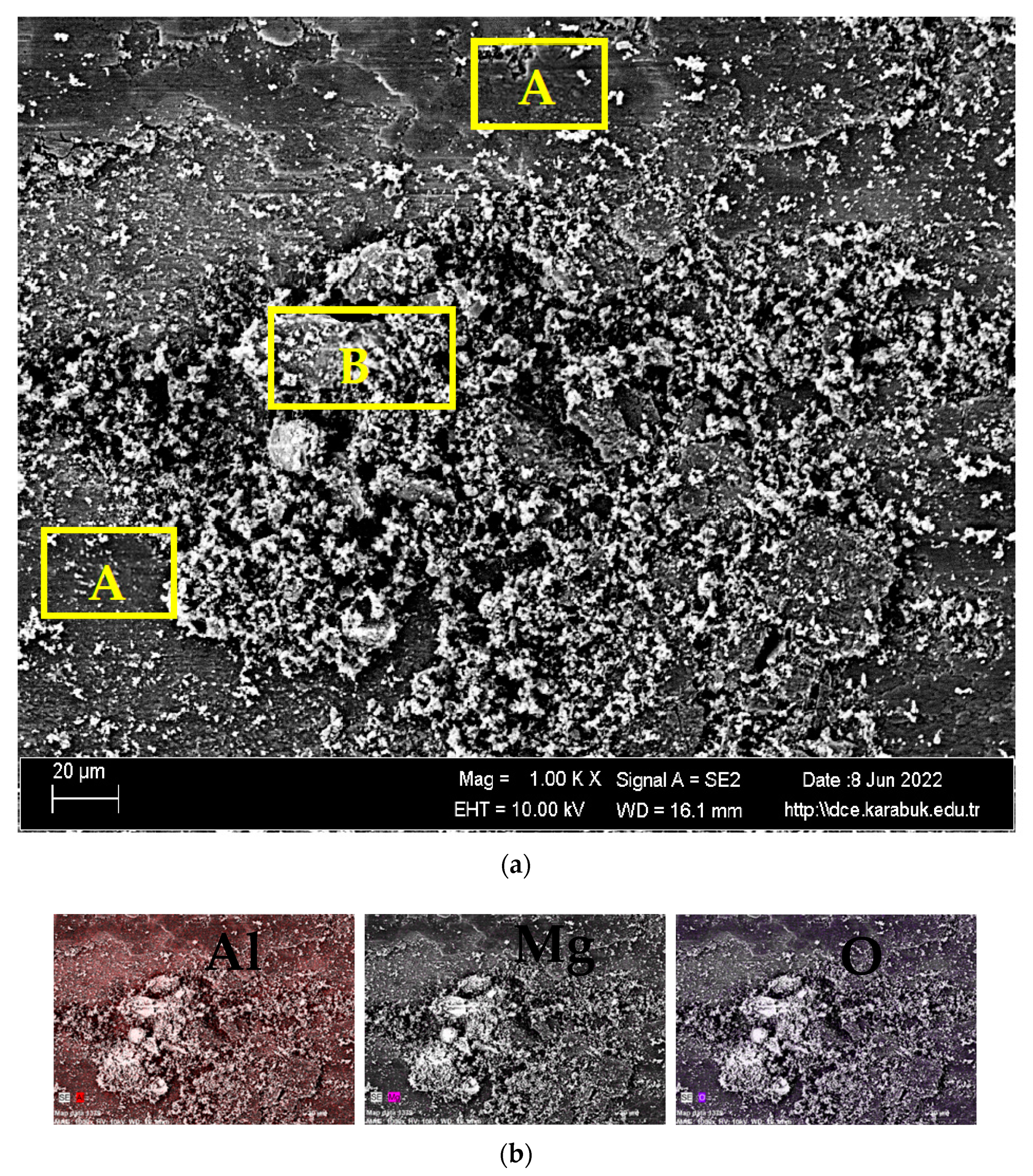

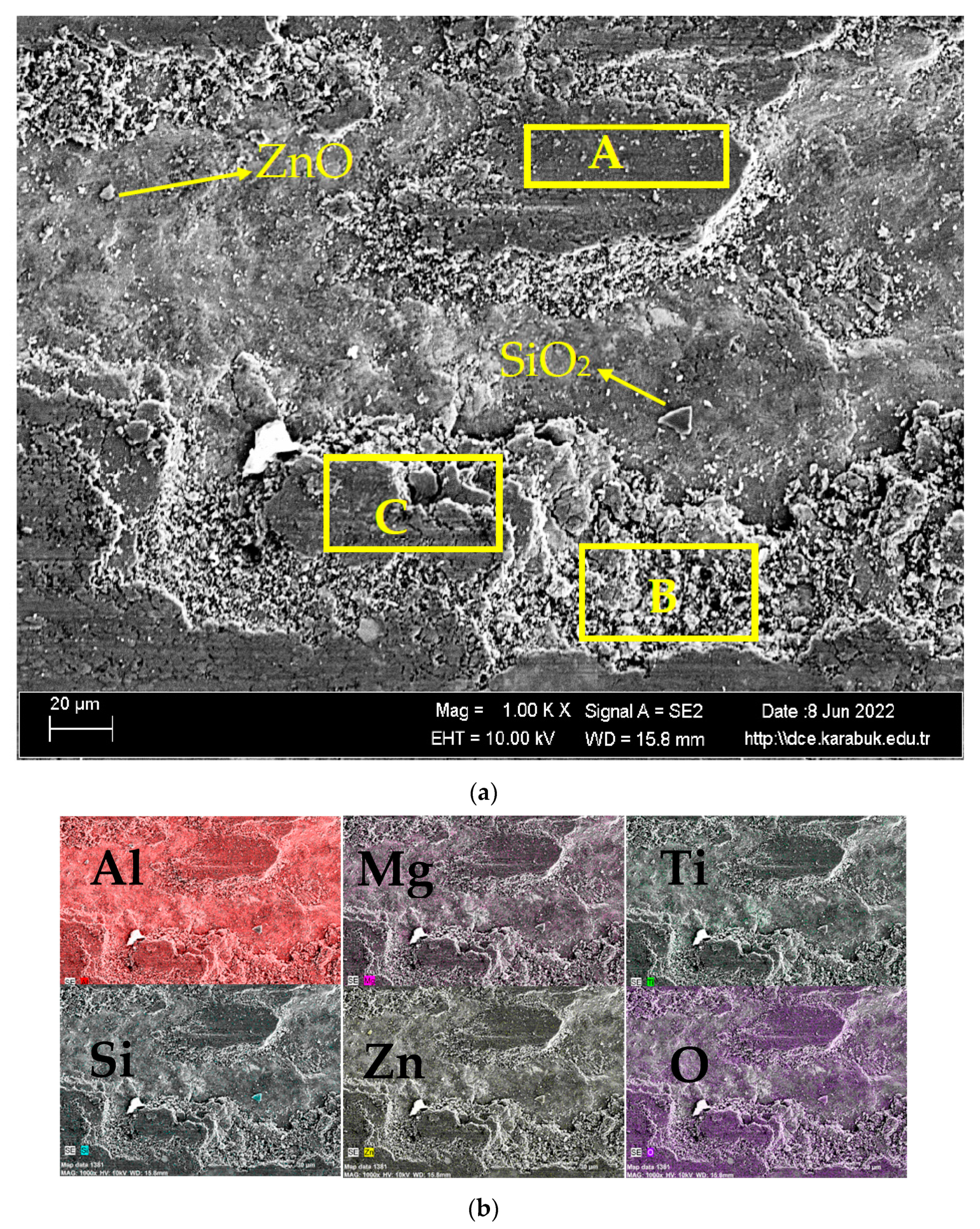
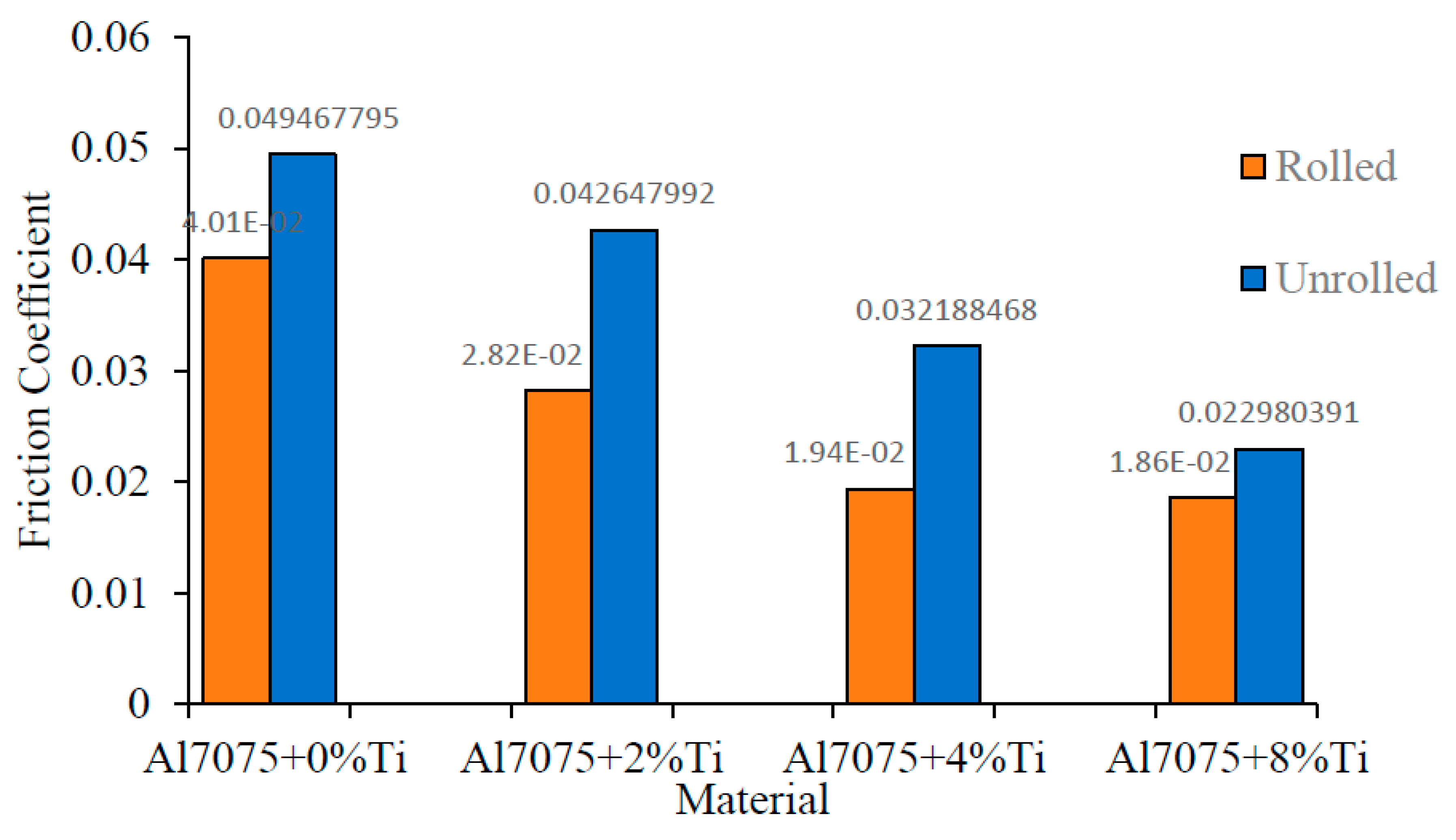
| Examined Alloys | Weight (g) | |||
|---|---|---|---|---|
| Al7075 | Al-10%Ti Master Alloy | Ti | Mg | |
| Al7075+0%Ti | 990.1 | 0 | 0 | 9.9 |
| Al7075+2%Ti | 790.2 | 200 | 20 | 9.8 |
| Al7075+4%Ti | 590.4 | 400 | 40 | 9.6 |
| Al7075+8%Ti | 190.2 | 800 | 80 | 9.2 |
| Chemical Composition | Si | Fe | Cu | Mn | Mg | Cr | Zn | Ti | Al |
|---|---|---|---|---|---|---|---|---|---|
| Al7075+0%Ti | 0.4 | 0.5 | 1.6 | 0.3 | 2.5 | 0.15 | 5.5 | 0.2 | Bal |
| Al7075+2%Ti | 0.3 | 0.39 | 1.26 | 0.24 | 2.5 | 0.12 | 4.34 | 2.2 | Bal |
| Al7075+4%Ti | 0.24 | 0.3 | 0.96 | 0.18 | 2.5 | 0.09 | 3.3 | 4.2 | Bal |
| Al7075+8%Ti | 0.08 | 0.1 | 0.32 | 0.06 | 2.5 | 0.03 | 1.1 | 8.2 | Bal |
| Spectrum | Mg | Al | Si | Ti | Fe | Cu | Zn |
|---|---|---|---|---|---|---|---|
| 1 | 2.91 | 85.13 | 0.07 | 0.00 | 0.00 | 4.21 | 7.69 |
| 2 | 2.87 | 85.42 | 0.13 | 0.00 | 0.00 | 3.54 | 8.04 |
| 3 | 9.13 | 61.55 | 1.07 | 0.00 | 0.48 | 12.16 | 15.61 |
| Spectrum | Mg | Al | Si | Ti | Fe | Cu | Zn |
|---|---|---|---|---|---|---|---|
| 1 | 1.79 | 88.74 | 0.00 | 0.28 | 0.00 | 6.54 | 2.65 |
| 2 | 0.43 | 64.24 | 0.08 | 35.20 | 0.00 | 0.00 | 0.05 |
| 3 | 0.01 | 11.27 | 0.14 | 0.00 | 2.62 | 85.96 | 0.00 |
| 4 | 2.33 | 65.65 | 0.28 | 31.12 | 0.00 | 0.24 | 0.37 |
Disclaimer/Publisher’s Note: The statements, opinions and data contained in all publications are solely those of the individual author(s) and contributor(s) and not of MDPI and/or the editor(s). MDPI and/or the editor(s) disclaim responsibility for any injury to people or property resulting from any ideas, methods, instructions or products referred to in the content. |
© 2023 by the authors. Licensee MDPI, Basel, Switzerland. This article is an open access article distributed under the terms and conditions of the Creative Commons Attribution (CC BY) license (https://creativecommons.org/licenses/by/4.0/).
Share and Cite
Nama, H.A.H.A.; Esen, İ.; Ahlatcı, H.; Karakurt, V. Effect of Aging Heat Treatment on Wear Behavior and Microstructure Characterization of Newly Developed Al7075+Ti Alloys. Materials 2023, 16, 4413. https://doi.org/10.3390/ma16124413
Nama HAHA, Esen İ, Ahlatcı H, Karakurt V. Effect of Aging Heat Treatment on Wear Behavior and Microstructure Characterization of Newly Developed Al7075+Ti Alloys. Materials. 2023; 16(12):4413. https://doi.org/10.3390/ma16124413
Chicago/Turabian StyleNama, Hamza A. H. Abo, İsmail Esen, Hayrettin Ahlatcı, and Volkan Karakurt. 2023. "Effect of Aging Heat Treatment on Wear Behavior and Microstructure Characterization of Newly Developed Al7075+Ti Alloys" Materials 16, no. 12: 4413. https://doi.org/10.3390/ma16124413





